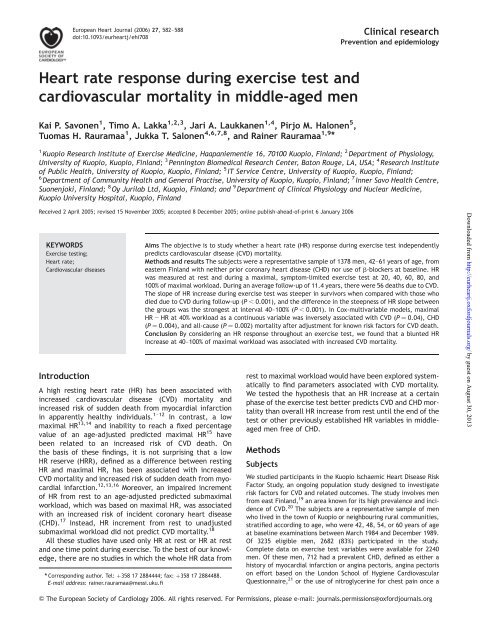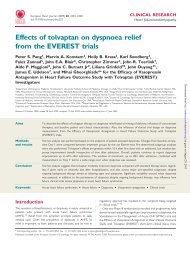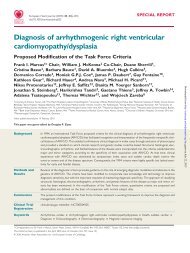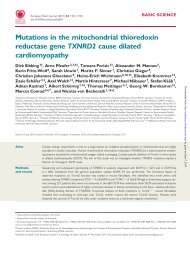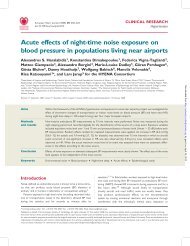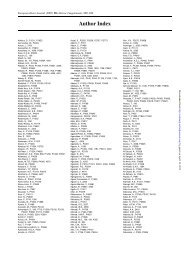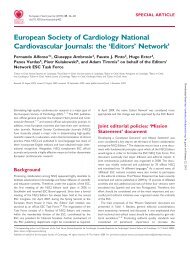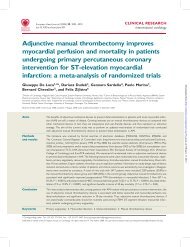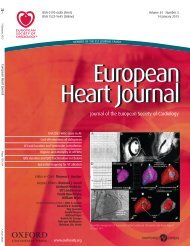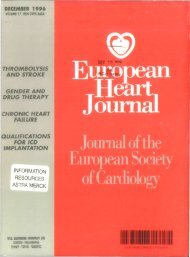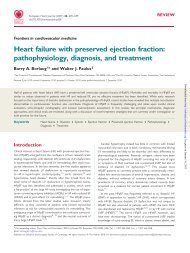Heart rate response during exercise test and cardiovascular ...
Heart rate response during exercise test and cardiovascular ...
Heart rate response during exercise test and cardiovascular ...
You also want an ePaper? Increase the reach of your titles
YUMPU automatically turns print PDFs into web optimized ePapers that Google loves.
European <strong>Heart</strong> Journal (2006) 27, 582–588<br />
doi:10.1093/eurheartj/ehi708<br />
Clinical research<br />
Prevention <strong>and</strong> epidemiology<br />
<strong>Heart</strong> <strong>rate</strong> <strong>response</strong> <strong>during</strong> <strong>exercise</strong> <strong>test</strong> <strong>and</strong><br />
<strong>cardiovascular</strong> mortality in middle-aged men<br />
Kai P. Savonen 1 , Timo A. Lakka 1,2,3 , Jari A. Laukkanen 1,4 , Pirjo M. Halonen 5 ,<br />
Tuomas H. Rauramaa 1 , Jukka T. Salonen 4,6,7,8 , <strong>and</strong> Rainer Rauramaa 1,9 *<br />
1 Kuopio Research Institute of Exercise Medicine, Haapaniementie 16, 70100 Kuopio, Finl<strong>and</strong>; 2 Department of Physiology,<br />
University of Kuopio, Kuopio, Finl<strong>and</strong>; 3 Pennington Biomedical Research Center, Baton Rouge, LA, USA; 4 Research Institute<br />
of Public Health, University of Kuopio, Kuopio, Finl<strong>and</strong>; 5 IT Service Centre, University of Kuopio, Kuopio, Finl<strong>and</strong>;<br />
6 Department of Community Health <strong>and</strong> General Practise, University of Kuopio, Kuopio, Finl<strong>and</strong>; 7 Inner Savo Health Centre,<br />
Suonenjoki, Finl<strong>and</strong>; 8 Oy Jurilab Ltd, Kuopio, Finl<strong>and</strong>; <strong>and</strong> 9 Department of Clinical Physiology <strong>and</strong> Nuclear Medicine,<br />
Kuopio University Hospital, Kuopio, Finl<strong>and</strong><br />
Received 2 April 2005; revised 15 November 2005; accepted 8 December 2005; online publish-ahead-of-print 6 January 2006<br />
KEYWORDS<br />
Exercise <strong>test</strong>ing;<br />
<strong>Heart</strong> <strong>rate</strong>;<br />
Cardiovascular diseases<br />
Introduction<br />
A high resting heart <strong>rate</strong> (HR) has been associated with<br />
increased <strong>cardiovascular</strong> disease (CVD) mortality <strong>and</strong><br />
increased risk of sudden death from myocardial infarction<br />
in apparently healthy individuals. 1–12 In contrast, a low<br />
maximal HR 13,14 <strong>and</strong> inability to reach a fixed percentage<br />
value of an age-adjusted predicted maximal HR 15 have<br />
been related to an increased risk of CVD death. On<br />
the basis of these findings, it is not surprising that a low<br />
HR reserve (HRR), defined as a difference between resting<br />
HR <strong>and</strong> maximal HR, has been associated with increased<br />
CVD mortality <strong>and</strong> increased risk of sudden death from myocardial<br />
infarction. 12,13,16 Moreover, an impaired increment<br />
of HR from rest to an age-adjusted predicted submaximal<br />
workload, which was based on maximal HR, was associated<br />
with an increased risk of incident coronary heart disease<br />
(CHD). 17 Instead, HR increment from rest to unadjusted<br />
submaximal workload did not predict CVD mortality. 18<br />
All these studies have used only HR at rest or HR at rest<br />
<strong>and</strong> one time point <strong>during</strong> <strong>exercise</strong>. To the best of our knowledge,<br />
there are no studies in which the whole HR data from<br />
* Corresponding author. Tel: þ358 17 2884444; fax: þ358 17 2884488.<br />
E-mail address: rainer.rauramaa@messi.uku.fi<br />
Aims The objective is to study whether a heart <strong>rate</strong> (HR) <strong>response</strong> <strong>during</strong> <strong>exercise</strong> <strong>test</strong> independently<br />
predicts <strong>cardiovascular</strong> disease (CVD) mortality.<br />
Methods <strong>and</strong> results The subjects were a representative sample of 1378 men, 42–61 years of age, from<br />
eastern Finl<strong>and</strong> with neither prior coronary heart disease (CHD) nor use of b-blockers at baseline. HR<br />
was measured at rest <strong>and</strong> <strong>during</strong> a maximal, symptom-limited <strong>exercise</strong> <strong>test</strong> at 20, 40, 60, 80, <strong>and</strong><br />
100% of maximal workload. During an average follow-up of 11.4 years, there were 56 deaths due to CVD.<br />
The slope of HR increase <strong>during</strong> <strong>exercise</strong> <strong>test</strong> was steeper in survivors when compared with those who<br />
died due to CVD <strong>during</strong> follow-up (P , 0.001), <strong>and</strong> the difference in the steepness of HR slope between<br />
the groups was the strongest at interval 40–100% (P , 0.001). In Cox-multivariable models, maximal<br />
HR 2 HR at 40% workload as a continuous variable was inversely associated with CVD (P ¼ 0.04), CHD<br />
(P ¼ 0.004), <strong>and</strong> all-cause (P ¼ 0.002) mortality after adjustment for known risk factors for CVD death.<br />
Conclusion By considering an HR <strong>response</strong> throughout an <strong>exercise</strong> <strong>test</strong>, we found that a blunted HR<br />
increase at 40–100% of maximal workload was associated with increased CVD mortality.<br />
rest to maximal workload would have been explored systematically<br />
to find parameters associated with CVD mortality.<br />
We <strong>test</strong>ed the hypothesis that an HR increase at a certain<br />
phase of the <strong>exercise</strong> <strong>test</strong> better predicts CVD <strong>and</strong> CHD mortality<br />
than overall HR increase from rest until the end of the<br />
<strong>test</strong> or other previously established HR variables in middleaged<br />
men free of CHD.<br />
Methods<br />
Subjects<br />
We studied participants in the Kuopio Ischaemic <strong>Heart</strong> Disease Risk<br />
Factor Study, an ongoing population study designed to investigate<br />
risk factors for CVD <strong>and</strong> related outcomes. The study involves men<br />
from east Finl<strong>and</strong>, 19 an area known for its high prevalence <strong>and</strong> incidence<br />
of CVD. 20 The subjects are a representative sample of men<br />
who lived in the town of Kuopio or neighbouring rural communities,<br />
stratified according to age, who were 42, 48, 54, or 60 years of age<br />
at baseline examinations between March 1984 <strong>and</strong> December 1989.<br />
Of 3235 eligible men, 2682 (83%) participated in the study.<br />
Complete data on <strong>exercise</strong> <strong>test</strong> variables were available for 2240<br />
men. Of these men, 712 had a prevalent CHD, defined as either a<br />
history of myocardial infarction or angina pectoris, angina pectoris<br />
on effort based on the London School of Hygiene Cardiovascular<br />
Questionnaire, 21 or the use of nitroglycerine for chest pain once a<br />
Downloaded from http://eurheartj.oxfordjournals.org/ by guest on August 30, 2013<br />
& The European Society of Cardiology 2006. All rights reserved. For Permissions, please e-mail: journals.permissions@oxfordjournals.org
HR <strong>response</strong> <strong>during</strong> <strong>exercise</strong> <strong>test</strong> <strong>and</strong> <strong>cardiovascular</strong> mortality 583<br />
week or more frequently. Of these men, 595 used b-blockers that<br />
reduce HR at rest <strong>and</strong> <strong>during</strong> <strong>exercise</strong>. After excluding these<br />
subjects, the final study sample included 1378 men free of CHD<br />
<strong>and</strong> not using b-blockers. None of the subjects reported using<br />
HR-blunting calcium blockers, such as verapamil <strong>and</strong> diltiazem.<br />
The study protocol was approved by the Research Ethics Committee<br />
of the University of Kuopio, <strong>and</strong> it complies with the Declaration of<br />
Helsinki. Each participant gave a written informed consent.<br />
Assessment of HR <strong>and</strong> other <strong>exercise</strong> <strong>test</strong> variables<br />
A maximal, symptom-limited <strong>exercise</strong> <strong>test</strong> was performed at<br />
baseline using an electrically braked cycle ergometer as described<br />
previously. 22,23 The primary aim of the study was to explore HR<br />
data from rest to maximal workload systematically instead of<br />
using arbitrarily chosen parts of recorded HR data. For that<br />
purpose, each subject’s <strong>exercise</strong> <strong>test</strong> was divided into five consequent<br />
periods of equal duration, <strong>and</strong> HR value was extracted from<br />
corresponding time points, i.e. rest, 20, 40, 60, 80, <strong>and</strong> 100% of<br />
maximal workload. For 556 men examined before June 1986, the<br />
<strong>test</strong>ing protocol comprised a 3-min warm-up at 50 W followed by<br />
a step-by-step increase in the workload by 20 W/min. The remaining<br />
822 men were <strong>test</strong>ed with a linear increase in the workload by<br />
20 W/min. Because two different protocols were used <strong>during</strong> the<br />
first 50 W, only the values at or .50 W were included into the analysis.<br />
Relative intensities of 20% were not considered in final<br />
analyses, because for 528 men examined before June 1986, the<br />
first workload of 50 W exceeded 20% of their maximal workload.<br />
For safety reasons <strong>and</strong> to obtain reliable information, the <strong>test</strong> was<br />
supervised by an experienced physician with the assistance of a<br />
trained nurse. The most common reasons for stopping the <strong>exercise</strong><br />
<strong>test</strong> were leg fatigue (787 men), exhaustion (237), breathlessness<br />
(128), <strong>and</strong> pain in the leg muscles, joints, or back (51). The <strong>test</strong><br />
was discontinued because of cardiorespiratory symptoms or abnormalities<br />
in 98 men. These included dyspnoea (39), arrhythmias (37), a<br />
marked change in systolic or diastolic blood pressure (8), dizziness<br />
(6), chest pain (4), <strong>and</strong> ischaemic electrocardiographic changes (4).<br />
HR was recorded from electrocardiogram (ECG) at rest, at the end<br />
of each 30-s interval <strong>during</strong> the <strong>exercise</strong> <strong>test</strong>, <strong>and</strong> at peak <strong>exercise</strong>.<br />
To express HR as a relative value, HRR was calculated as maximal<br />
HR 2 resting HR. Resting HR was expressed as the lowest HR<br />
value, whether measured in lying position before the <strong>test</strong> or while<br />
sitting on bicycle at the initiation of the <strong>test</strong>. Systolic blood pressure<br />
<strong>response</strong> to <strong>exercise</strong> was calculated as maximal systolic blood<br />
pressure 2 resting systolic blood pressure, <strong>and</strong> the <strong>response</strong> was<br />
also related to the duration of the <strong>test</strong>. Maximal oxygen uptake<br />
(VO 2max ) was defined as the highest value recorded over a 30-s interval.<br />
The criteria for myocardial ischaemia <strong>during</strong> <strong>exercise</strong> <strong>test</strong> were<br />
ischaemic changes in ECG defined as horizontal or downsloping ST<br />
depression .1.0 mm at 80 ms after the J-point.<br />
Assessment of other risk factors<br />
CVD history was defined as a history of cardiomyopathy, heart<br />
failure, stroke, or claudication. Cigarette smoking was defined as<br />
cigarette-years, which denotes the lifelong exposure to smoking<br />
<strong>and</strong> was estimated as the product of years smoked <strong>and</strong> the<br />
number of cigarettes smoked daily at the time of examination. 24<br />
Diabetes was defined as a history of taking medication for diabetes<br />
or fasting blood glucose 6.7 mmol/L. The collection of blood<br />
specimens <strong>and</strong> the assessment of other risk factors, including<br />
alcohol consumption, body mass index (BMI), serum lipoproteins,<br />
<strong>and</strong> systolic <strong>and</strong> diastolic blood pressure at rest, have been<br />
described elsewhere. 22–24<br />
Ascertainment of follow-up events<br />
Deaths were ascertained by computer linkage to the national death<br />
registry using a social security number that every Finn has. There<br />
were no losses to follow-up. All deaths that occurred between<br />
study enrolment from 20 March 1984 to 5 December 1989 <strong>and</strong> 31<br />
December 1998 were included. CVD <strong>and</strong> CHD deaths were coded<br />
according to the Ninth International Classification of Diseases<br />
(code nos 390–459 <strong>and</strong> 410–414, respectively) or the Tenth<br />
International Classification of Diseases (code nos I00–I99 <strong>and</strong><br />
I20–I25, respectively). CVD <strong>and</strong> CHD deaths were used as the<br />
primary endpoints <strong>and</strong> all-cause death as the secondary endpoint.<br />
We used CVD <strong>and</strong> CHD deaths as the primary endpoints because<br />
HR <strong>response</strong> <strong>during</strong> <strong>exercise</strong> primarily reflects <strong>cardiovascular</strong><br />
status <strong>and</strong> most likely predicts CVD mortality.<br />
Statistical analysis<br />
The analysis of variance (ANOVA) for repeated measures, adjusted<br />
for age <strong>and</strong> the length of follow-up, was used to detect whether<br />
the slopes of HR increase of men who died <strong>during</strong> follow-up <strong>and</strong><br />
survivors differed from the beginning of the <strong>test</strong> or only later<br />
<strong>during</strong> the <strong>test</strong>. In order to eliminate dispersion from compound<br />
symmetry assumption (equal correlations between measurements),<br />
Greenhouse-Geisser corrected degrees of freedom were used when<br />
<strong>test</strong>ing the effects in ANOVA. The Helmert contrasts, which compare<br />
HRs at each relative workload with the mean HRs of the next<br />
relative workloads, were used to locate the phase of the <strong>test</strong><br />
(rest, 40, 60, 80, <strong>and</strong> 100% of maximal workload) where the HR<br />
slopes of men who died <strong>during</strong> follow-up <strong>and</strong> survivors started to<br />
diverge. The statistically most significant contrast was used to<br />
construct a new variable. Differences in baseline data between<br />
those who died <strong>and</strong> survivors were <strong>test</strong>ed with linear- <strong>and</strong> logisticregression<br />
analyses <strong>and</strong> Mann–Whitney U <strong>test</strong> by adjusting for age<br />
<strong>and</strong> length of follow-up.<br />
The new HR variable constructed according to ANOVA for<br />
repeated measures was entered into forced Cox-proportional<br />
hazards’ regression models. If possible, covariates were entered<br />
as uncategorized into Cox models. Two different sets of covariates<br />
were used: (i) age <strong>and</strong> examination year; (ii) age, examination<br />
year, alcohol consumption, BMI, cigarette smoking, CVD history,<br />
diabetes, serum LDL-cholesterol, systolic blood pressure at rest,<br />
<strong>and</strong> myocardial ischaemia <strong>during</strong> <strong>exercise</strong>. To compare the predictive<br />
value of HR40–100 <strong>and</strong> other <strong>exercise</strong> <strong>test</strong> variables, a stepwise<br />
Cox-regression analysis was used. Relative hazards, adjusted for risk<br />
factors, were estimated as antilogarithms of coefficients from<br />
multivariable models. Their confidence intervals (CIs) were estimated<br />
under the assumption of asymptotic normality of the<br />
estimates. To detect the best cut-off point for a new variable,<br />
the dichotomization cut-off point that maximized the log-rank<br />
<strong>test</strong> statistics was sought, <strong>and</strong> the predictive power of this categorized<br />
variable was <strong>test</strong>ed by using Cox models. Finally, we <strong>test</strong>ed<br />
potential interactions of the new HR variable with other risk<br />
factors for death with Cox models by adjusting for age <strong>and</strong> examination<br />
year. All <strong>test</strong>s for statistical significance were two sided.<br />
Statistical analyses were performed by using SPSS 11.5. for<br />
Windows (SPSS, Inc., Chicago, IL, USA).<br />
Results<br />
At the beginning of the follow-up, the median age of the<br />
subjects was 54 years (range 42–61 years). In ANOVA for<br />
repeated measures, the slope of HR increase was steeper<br />
in survivors when compared with those who died due to<br />
CVD <strong>during</strong> follow-up (F ¼ 12.9; df ¼ 1.757; P , 0.001 for<br />
interaction effect adjusting for age <strong>and</strong> length of followup)<br />
(Figure 1). By using Helmert contrasts, the difference<br />
in the steepness of HR slope between the groups was the<br />
strongest at interval 40–100% (F ¼ 19.6; P , 0.001). On<br />
the basis of these results, a new variable called HR40–100<br />
was constructed as maximal HR 2 HR at 40% workload. The<br />
average HR40–100 was 54 b.p.m. (SD 13 b.p.m.) in the<br />
whole study population, 55 b.p.m. (SD 13 b.p.m.) in<br />
Downloaded from http://eurheartj.oxfordjournals.org/ by guest on August 30, 2013
584 K.P. Savonen et al.<br />
Figure 1 <strong>Heart</strong> <strong>rate</strong> (mean + SD) as a function of relative intensity<br />
(percentage of maximal workload reached in <strong>exercise</strong> <strong>test</strong>) in those who died<br />
due to CVD <strong>during</strong> follow-up (dashed line) <strong>and</strong> survivors (continuous line).<br />
survivors, <strong>and</strong> 45 b.p.m. (SD 13 b.p.m.) in those who died<br />
due to CVD <strong>during</strong> follow-up (P , 0.001 for difference<br />
between survivors <strong>and</strong> deceased). Baseline characteristics<br />
in survivors <strong>and</strong> those who died of CVD <strong>during</strong> the followup<br />
are shown in Table 1. HR40–100 correlated negatively<br />
with resting HR (r ¼ 20.33; P , 0.001) <strong>and</strong> positively<br />
with HR reserve (r ¼ 0.79; P , 0.001) <strong>and</strong> maximal HR<br />
(r ¼ 0.66; P , 0.001).<br />
HR increment between 40 <strong>and</strong> 100% of maximal<br />
workload <strong>and</strong> all-cause <strong>and</strong> CVD mortality<br />
The average follow-up time to any death or the end of<br />
follow-up was 11.4 years (range 0.3–14.8 years). In the<br />
present sample, a total of 146 (10.6%) deaths occurred<br />
<strong>during</strong> the follow-up period. There were 56 CVD deaths<br />
(4.1%), of which 37 were due to CHD (2.7%). When adjusted<br />
for age <strong>and</strong> examination year, CVD mortality decreased by<br />
45% (95% CI 28–58; P , 0.001), CHD mortality decreased<br />
by 56% (95% CI 38–68; P , 0.001), <strong>and</strong> all-cause mortality<br />
decreased by 37% (95% CI 26–46; P , 0.001) with 1 SD<br />
(13 b.p.m.) increment in HR40–100.<br />
To investigate independent associations of HR40–100, it was<br />
entered simultaneously with age, examination year, <strong>and</strong><br />
known risk factors for CVD death into Cox models (Table 2).<br />
CVD mortality decreased by 26% (95% CI 1–44; P ¼ 0.04),<br />
CHD mortality decreased by 41% (95% CI 16–59; P ¼ 0.004),<br />
<strong>and</strong> all-cause mortality decreased by 25% (95% CI 10–37;<br />
P ¼ 0.002) with 1 SD (13 b.p.m.) increment in HR40–100.<br />
HR40–100 predicted also death due to non-<strong>cardiovascular</strong><br />
causes: mortality decreased by 24% (95% CI 5–39; P ¼ 0.02)<br />
with 1 SD (13 b.p.m.) increment in HR40–100. HR increase<br />
from rest to 40% of maximal workload was not associated<br />
with CVD (P ¼ 0.65), CHD (P ¼ 0.86), or all-cause mortality<br />
(P ¼ 0.27).<br />
HR increment between 40 <strong>and</strong> 100% of maximal<br />
workload, CVD mortality, <strong>and</strong> other <strong>exercise</strong><br />
<strong>test</strong>-derived variables<br />
The associations of HR40–100 with mortality were compared<br />
also with those of VO 2max , resting HR, maximal HR, HR<br />
reserve, <strong>and</strong> systolic blood pressure <strong>response</strong>. All variables<br />
were considered as continuous variables, <strong>and</strong> relative risks<br />
were calculated for 1 SD increment. HR40–100 significantly<br />
predicted mortality after adjustment for known risk<br />
factors (Table 2). When entered into the same model,<br />
other <strong>exercise</strong> <strong>test</strong> variables had weaker associations with<br />
CVD <strong>and</strong> CHD mortality than HR40–100 but VO 2max was a<br />
stronger predictor of all-cause death than HR40–100<br />
(Table 3). When HR40–100 <strong>and</strong> each of the other <strong>exercise</strong><br />
<strong>test</strong> variables were entered into the fully adjusted model<br />
using stepwise method, HR40–100 remained in the model<br />
for CVD <strong>and</strong> CHD mortality, whereas other <strong>exercise</strong> <strong>test</strong><br />
variables did not. In the corresponding model for all-cause<br />
mortality, both VO 2max <strong>and</strong> HR40–100 were included in the<br />
model but VO 2max was a stronger predictor (P ¼ 0.008)<br />
than HR40–100 (P ¼ 0.05).<br />
The best cut-off point of HR40–100 for predicting CVD<br />
mortality was 43 b.p.m., <strong>and</strong> 272 subjects (20%) had low<br />
HR40–100 (,43 b.p.m.). When HR40–100 was entered as a<br />
dichotomous variable into a Cox model, the strongest predictor<br />
of CVD death was smoking (P , 0.001) followed by a<br />
low HR40–100 (RR 2.4; 95% CI 1.4–4.2; P ¼ 0.002), myocardial<br />
ischaemia <strong>during</strong> <strong>exercise</strong> (P ¼ 0.007), high systolic<br />
blood pressure at rest (P ¼ 0.007), high age (P ¼ 0.01),<br />
<strong>and</strong> CVD history (P ¼ 0.05). The strongest predictor of CHD<br />
death was a low HR40–100 (RR 4.3; 95% CI 2.1–8.7;<br />
P , 0.001) followed by myocardial ischaemia <strong>during</strong> <strong>exercise</strong><br />
(P ¼ 0.001) <strong>and</strong> smoking (P ¼ 0.002).<br />
Analyses stratified according to known risk factors for CVD<br />
death are presented in Table 4. A low HR40–100 predicted<br />
CVD death in all subgroups except in men with lower<br />
serum LDL-cholesterol levels (,3.5 mmol/L; n ¼ 428;<br />
P ¼ 0.51).<br />
Discussion<br />
The main finding of the present study is that a blunted HR<br />
increase between 40 <strong>and</strong> 100% of maximal workload<br />
(HR40–100) <strong>during</strong> an <strong>exercise</strong> <strong>test</strong> was associated with<br />
increased CVD, CHD, <strong>and</strong> all-cause mortality in a<br />
population-based sample of middle-aged men free of CHD.<br />
The magnitude of the association was comparable with<br />
that of other major CVD risk factors.<br />
In the present study, CVD mortality was associated with<br />
HR increment from 40 to 100% of maximal workload,<br />
whereas an association was not found with HR increase<br />
from rest to 40% of maximal workload. HR40–100 was a<br />
better predictor of CVD death than HR reserve (HR increase<br />
from rest to maximum) or a variable quantifying a submaximal<br />
HR increment by Lauer et al., 17 both previously established<br />
predictors of CVD death 13,16 or incident CHD. 17 A<br />
possible reason for this is that HR40–100 does not include<br />
the early portion of an HR slope, whereas HR reserve <strong>and</strong><br />
HR variable by Lauer et al. 17 include also HR range ,40%<br />
of maximal workload.<br />
During dynamic <strong>exercise</strong>, the initial rise in the HR is<br />
mainly due to the withdrawal of vagal tone until HR<br />
approaches 100 b.p.m., whereas from that HR level<br />
onward, the more slowly responding sympathetic system<br />
begins to dominate the control of HR up to maximal<br />
values. 25,26 In the present study, a mean HR at 40% of<br />
maximal workload was 100 b.p.m. (Table 1). This suggests<br />
that a reduced ability to increase sympathetic activity may<br />
be the underlying factor mediating the association between<br />
a low increment of HR .40% of maximal workload <strong>and</strong><br />
increased CVD mortality. Instead, a vagally mediated early<br />
Downloaded from http://eurheartj.oxfordjournals.org/ by guest on August 30, 2013
HR <strong>response</strong> <strong>during</strong> <strong>exercise</strong> <strong>test</strong> <strong>and</strong> <strong>cardiovascular</strong> mortality 585<br />
Table 1 Baseline characteristics according to CVD death <strong>during</strong> follow-up in 1378 men with no history of CHD or use of<br />
b-blockers at baseline<br />
Characteristics Mean/median (SD/range) or proportion P-value<br />
for difference<br />
All men<br />
(n ¼ 1378)<br />
Men who died<br />
of CVD <strong>during</strong><br />
follow-up (n ¼ 56)<br />
Survivors<br />
(n ¼ 1322)<br />
between groups a<br />
Age (years) 54 (42–61) 54 (42–61) 52 (42–61) 0.003<br />
BMI (kg/m 2 ) 26.5 (3.4) 27.8 (3.9) 26.5 (3.3) 0.01<br />
Cigarette smoking (cigarette-years) b 147 (301) 315 (465) 140 (290) 0.02<br />
Alcohol consumption (g/week) 74 (113) 120 (191) 72 (108) 0.12<br />
CVD history (%) c 14.7 28.6 14.1 0.01<br />
Diabetes (%) d 3.7 8.9 3.5 0.18<br />
Serum LDL-cholesterol (mmol/L) 3.98 (0.97) 4.30 (1.04) 3.97 (0.96) 0.001<br />
Systolic blood pressure at rest<br />
133 (16) 143 (19) 132 (15) ,0.001<br />
(mmHg)<br />
Maximal oxygen uptake (L/min) 2.6 (0.6) 2.3 (0.5) 2.6 (0.6) 0.03<br />
Exercise <strong>test</strong> duration (s) 627 (137) 543 (121) 631 (137) 0.002<br />
Myocardial ischaemia <strong>during</strong><br />
13.8 33.9 12.9 ,0.001<br />
<strong>exercise</strong> (%) e<br />
Systolic blood pressure<br />
76 (24) 77 (25) 76 (24) 0.50<br />
<strong>response</strong> (mmHg) f<br />
Systolic blood pressure<br />
7.5 (2.7) 8.6 (3.1) 7.5 (2.6) 0.02<br />
<strong>response</strong> in relation to <strong>test</strong><br />
duration (mmHg/min)<br />
Resting HR (b.p.m.) 74 (13) 78 (15) 74 (13) 0.02<br />
Chronotropic incompetence (%) g 10.1 14.3 9.9 0.55<br />
Maximal HR (b.p.m.) 163 (17) 154 (18) 163 (17) 0.003<br />
HR reserve (b.p.m.) h 89 (20) 76 (19) 89 (19) ,0.001<br />
HR at 40% of maximal workload 108 (13) 109 (14) 108 (13) 0.34<br />
(b.p.m.)<br />
HR increment between 40 <strong>and</strong><br />
100% of maximal workload<br />
(b.p.m.)<br />
54 (13) 45 (13) 55 (13) ,0.001<br />
a Differences between groups were adjusted for age <strong>and</strong> length of follow-up <strong>and</strong> <strong>test</strong>ed with logistic-regression analysis for CVD<br />
history, chronotropic incompetence, diabetes, <strong>and</strong> myocardial ischaemia <strong>during</strong> <strong>exercise</strong> <strong>and</strong> with linear-regression analysis for<br />
rest of the variables. An age difference between groups was <strong>test</strong>ed with Mann–Whitney U <strong>test</strong>.<br />
b Cigarette-years denotes the lifelong exposure to smoking which was estimated as the product of years smoked <strong>and</strong> the number of<br />
cigarettes smoked daily at the time of examination. 24<br />
c CVD was defined as a history of cardiomyopathy, heart failure, stroke, or claudication.<br />
d Diabetes was defined as a history of taking medication for treatment of diabetes or fasting glucose 6.7 mmol/L.<br />
e The criteria for myocardial ischaemia <strong>during</strong> <strong>exercise</strong> <strong>test</strong> were ischaemic changes in ECG defined as horizontal or downsloping ST<br />
depression 1.0 mm at 80 ms after the J-point.<br />
f Systolic blood pressure <strong>response</strong> was calculated as maximal systolic blood pressure 2 resting systolic blood pressure.<br />
g Chronotropic incompetence was defined as an inability to reach 85% of the age-predicted (220 2 age in years) maximal HR.<br />
h HR reserve was calculated as maximal HR 2 resting HR.<br />
Downloaded from http://eurheartj.oxfordjournals.org/ by guest on August 30, 2013<br />
increment of HR does not seem to be informative from the<br />
predictive point of view. In contrast, a resting HR, which is<br />
also largely defined by vagal activity, has previously been<br />
associated with an increased risk of premature CVD<br />
death, 1–12 <strong>and</strong> a similar trend was found also in this study.<br />
Patients with advanced CHD <strong>and</strong> heart failure show a high<br />
resting HR <strong>and</strong> a poor ability to increase HR <strong>during</strong> <strong>exercise</strong>.<br />
27–29 These findings have been attributed to a low<br />
number of b-adrenergic receptors <strong>and</strong> desensitization of<br />
myocardial b-adrenergic receptors secondary to increased<br />
sympathetic activity. 27–29 A low HR40–100 together with a<br />
high resting HR in the present study may indicate a milder<br />
autonomic nervous system aberration frequently found in<br />
cardiac patients. 13 Experimental data show that cardiac<br />
autonomic regulation plays an important role in occurrence<br />
of life-threatening arrhythmias <strong>during</strong> acute cardiac<br />
ischaemia. 30<br />
Other mechanisms by which an impaired HR <strong>response</strong><br />
could be associated with increased CVD mortality include<br />
<strong>exercise</strong>-induced myocardial ischaemia 31 <strong>and</strong> a decreased<br />
cardiorespiratory fitness. 17 An impaired HR <strong>response</strong> has<br />
also been speculated to be a parasympathetic reflex<br />
triggered by irritation of mechanoreceptors in the left<br />
ventricular wall (the Bezold–Jarisch reflex) subsequent to<br />
deterio<strong>rate</strong>d myocardial contractility. 32,33 However, a low<br />
HR40–100 predicted CVD <strong>and</strong> all-cause mortality independent<br />
of <strong>exercise</strong>-induced ischaemia.<br />
First, the strength of our study is that we have a representative<br />
population-based sample of middle-aged men.<br />
Secondly, the participation <strong>rate</strong> was high <strong>and</strong> there were
586 K.P. Savonen et al.<br />
Table 2 Risk factor for CVD, CHD, <strong>and</strong> all-cause death in 1378 men with no history of coronary heart disease or use of b-blockers at<br />
baseline a<br />
Risk factor Death due to CVD Death due to coronary heart disease All-cause death<br />
Relative risk<br />
(95% CI)<br />
P-value<br />
Relative risk<br />
(95% CI)<br />
P-value<br />
Relative risk<br />
(95% CI)<br />
P-value<br />
Age (for each increment<br />
1.08 (1.02–1.16) 0.02 1.04 (0.97–1.12) 0.31 1.08 (1.04–1.13) ,0.001<br />
of 1 year)<br />
Alcohol consumption<br />
1.14 (0.62–2.09) 0.68 0.97 (0.45–2.09) 0.94 1.52 (1.06–2.19) 0.02<br />
91 g/week (highest<br />
fourth vs. others)<br />
BMI (for each increment<br />
1.20 (0.93–1.54) 0.16 1.19 (0.88–1.60) 0.26 1.07 (0.91–1.26) 0.42<br />
of 3.4 kg/m 2 )<br />
CVD history (yes vs. no) 1.81 (0.98–3.34) 0.06 1.66 (0.77–3.57) 0.20 1.02 (0.66–1.58) 0.93<br />
Cigarette smoking (for each 1.43 (1.19–1.72) ,0.001 1.41 (1.11–1.78) 0.004 1.43 (1.29–1.60) ,0.001<br />
increment of 301<br />
cigarette-years)<br />
Diabetes (yes vs. no) 1.29 (0.48–3.47) 0.62 1.14 (0.33–4.00) 0.84 1.25 (0.64–2.45) 0.52<br />
Myocardial ischaemia <strong>during</strong> 2.35 (1.32–4.19) 0.004 3.32 (1.68–6.59) 0.001 1.25 (0.83–1.90) 0.29<br />
<strong>exercise</strong> (yes vs. no)<br />
Serum LDL-cholesterol<br />
1.16 (0.89–1.51) 0.28 1.26 (0.92–1.72) 0.15 1.01 (0.86–1.18) 0.92<br />
(for each increment of<br />
0.97 mmol/L)<br />
Systolic blood pressure at rest 1.36 (1.09–1.70) 0.008 1.19 (0.89–1.58) 0.24 1.28 (1.11–1.49) 0.001<br />
(for each increment of<br />
16 mmHg)<br />
HR increment between 40 <strong>and</strong><br />
100% of maximal workload<br />
(for each increment of 13 b.p.m.)<br />
0.74 (0.56–0.99) 0.04 0.59 (0.41–0.84) 0.004 0.75 (0.63–0.90) 0.002<br />
a From Cox-regression model adjusted for age, examination year, <strong>and</strong> all variables, as shown. Except for age, alcohol consumption, CVD history, diabetes,<br />
<strong>and</strong> myocardial ischaemia, the relative risks were calculated for a change of 1 SD, as shown. Abbreviations as in Table 1.<br />
Table 3 Exercise <strong>test</strong> variables as a risk factor for CVD, CHD, <strong>and</strong> all-cause death in 1378 men with no history of CHD or use of b-blockers at<br />
baseline a<br />
Risk factor Death due to CVD Death due to CHD All-cause death<br />
Maximal oxygen uptake (for each<br />
increment of 0.6 L/min)<br />
Systolic blood pressure <strong>response</strong><br />
(for each increment of 24 mmHg)<br />
Systolic blood pressure <strong>response</strong> in<br />
relation to <strong>test</strong> duration (for each<br />
increment of 2.7 mmHg/min)<br />
Resting HR (for each increment<br />
of 13 b.p.m.)<br />
Maximal HR (for each increment<br />
of 17 b.p.m.)<br />
HR reserve (for each increment<br />
of 20 b.p.m.)<br />
Relative risk (95% CI) P-value Relative risk (95% CI) P-value Relative risk (95% CI) P-value<br />
0.74 (0.52–1.06) 0.10 0.57 (0.36–0.90) 0.02 0.66 (0.53–0.83) ,0.001<br />
1.18 (0.90–1.54) 0.23 1.19 (0.85–1.66) 0.31 0.90 (0.76–1.06) 0.21<br />
1.16 (0.94–1.44) 0.17 1.24 (0.95–1.61) 0.11 1.05 (0.90–1.22) 0.56<br />
1.21 (0.94–1.55) 0.14 1.35 (1.01–1.81) 0.04 1.08 (0.92–1.27) 0.37<br />
0.98 (0.74–1.30) 0.90 0.90 (0.64–1.27) 0.55 0.78 (0.65–0.94) 0.007<br />
0.84 (0.63–1.12) 0.23 0.70 (0.49–1.00) 0.05 0.76 (0.64–0.91) 0.003<br />
Downloaded from http://eurheartj.oxfordjournals.org/ by guest on August 30, 2013<br />
a From Cox-regression model adjusted for age, examination year, alcohol consumption, BMI, cigarette smoking, CVD history, diabetes, serum LDL-cholesterol,<br />
systolic blood pressure at rest, <strong>and</strong> myocardial ischaemia <strong>during</strong> <strong>exercise</strong>. The relative risks were calculated for a change of 1 SD, as shown. Abbreviations as<br />
in Table 1.<br />
no losses to follow-up. Thirdly, we have reliable data on<br />
mortality because deaths were ascertained by National<br />
Death Registry using a social security number. Next,<br />
comprehensive assessment of health habits <strong>and</strong> <strong>cardiovascular</strong><br />
risk factors allowed us to investigate the independent<br />
association of HR40–100 with CVD mortality. Finally,<br />
cardiorespiratory fitness was measured objectively by<br />
direct expiratory gas analysis instead of using predicted<br />
values.<br />
A limitation of the study is that only men were enrolled.<br />
Therefore, generalization of the present findings to female<br />
populations should be done with caution. The extent to
HR <strong>response</strong> <strong>during</strong> <strong>exercise</strong> <strong>test</strong> <strong>and</strong> <strong>cardiovascular</strong> mortality 587<br />
Table 4 Associations between a low HR increment between 40 <strong>and</strong> 100% of maximal workload <strong>and</strong> CVD death in<br />
all men <strong>and</strong> in subgroups in 1378 men with no history of CHD or use of b-blockers at baseline a<br />
Stratifying variable<br />
Relative risk<br />
(95% CI)<br />
P-value<br />
P-value for<br />
interaction<br />
All men (n ¼ 1378) 3.57 (2.09–6.09) ,0.001<br />
Alcohol consumption<br />
91 g/week, the highest<br />
3.04 (1.19–7.80) 0.02 0.37<br />
fourth (n ¼ 344)<br />
,91 g/week (n ¼ 1034) 3.89 (2.02–7.49) ,0.001<br />
BMI<br />
30.0 kg/m 2 (n ¼ 195) 3.71 (1.18–11.65) 0.03 1.00<br />
,30.0 kg/m 2 (n ¼ 1183) 3.43 (1.86–6.32) ,0.001<br />
CVD history<br />
Yes (n ¼ 203) 4.57 (1.64–12.76) 0.004 0.48<br />
No (n ¼ 1175) 3.13 (1.66–5.93) ,0.001<br />
Cigarette smoking<br />
Yes (n ¼ 384) 3.13 (1.29–7.56) 0.01 0.62<br />
No (n ¼ 994) 3.76 (1.90–7.45) ,0.001<br />
Maximal oxygen uptake ,2.35 L/min<br />
2.35 L/min, the lowest<br />
2.90 (1.42–5.94) 0.003 0.64<br />
third (n ¼ 460)<br />
.2.35 L/min (n ¼ 918) 3.73 (1.61–8.64) 0.002<br />
Myocardial ischaemia <strong>during</strong> <strong>exercise</strong><br />
Yes (n ¼ 190) 4.84 (1.75–13.38) 0.002 0.49<br />
No (n ¼ 1188) 2.67 (1.37–5.19) 0.004<br />
Serum LDL-cholesterol<br />
3.5 mmol/L (n ¼ 950) 4.27 (2.33–7.83) ,0.001 0.15<br />
,3.5 mmol/L (n ¼ 428) 1.57 (0.41–5.96) 0.51<br />
Systolic blood pressure at rest<br />
140 mmHg (n ¼ 389) 2.82 (1.39–5.76) ,0.001 0.48<br />
,140 mmHg (n ¼ 989) 3.75 (1.68–8.37) 0.001<br />
a From Cox-regression model adjusted for age <strong>and</strong> examination year. If not otherwise specified, cut-off values are based on<br />
commonly used recommendations. Abbreviations as in Table 1.<br />
which age, underlying diseases, regular physical activity,<br />
<strong>and</strong> cardioactive medications influence HR40–100 or<br />
modify its association with CVD mortality deserves further<br />
studies. It is possible that part of the association is explained<br />
by residual confounding due to other risk factors. However,<br />
we adjusted for the most important risk factors <strong>and</strong> the<br />
results remained similar. We do not know whether<br />
HR40–100 changed <strong>during</strong> the long follow-up period <strong>and</strong><br />
how the possible changes have affected our results. It is<br />
likely that HR40–100 decreases with ageing as a consequence<br />
of a decrease in maximal HR. However, age was<br />
controlled for in the statistical analyses. We could not<br />
investigate whether relative intensities ,40% predict CVD<br />
mortality, because for 528 men, such low intensities could<br />
not be assessed owing to a <strong>test</strong>ing protocol. Therefore, we<br />
cannot state whether the association of a blunted<br />
HR increase with increased CVD mortality manifests<br />
already at relative workloads ,40%. Finally, the association<br />
between HR40–100 <strong>and</strong> mortality should be confirmed in<br />
other populations before any definitive conclusions can be<br />
made regarding its applicability as a predictor of CVD death.<br />
HR40–100 was a strong predictor of premature CVD <strong>and</strong><br />
all-cause mortality in middle-aged men free of CHD. A low<br />
HR40–100 can identify persons with an increased risk of CVD<br />
death independent of parameters measured at rest<br />
or maximal exertion. Our findings suggest that an assessment<br />
of HR <strong>response</strong> to <strong>exercise</strong> between 40 <strong>and</strong> 100% of maximal<br />
workload may be useful in the prediction of CVD death.<br />
Acknowledgements<br />
This study was supported by grants from the Ministry of Education in<br />
Finl<strong>and</strong> (74/722/2003), from the Finnish Cultural Foundation of<br />
Northern Savo, <strong>and</strong> from the Foundation of Sports Institutes in Finl<strong>and</strong>.<br />
Conflict of interest: no conflict of interests exists including any<br />
financial or other kinds of associations.<br />
References<br />
1. Dyer AR, Persky V, Stamler J, Paul O, Shekelle RB, Berkson DM, Lepper M,<br />
Schoenberger JA, Lindberg HA. <strong>Heart</strong> <strong>rate</strong> as a prognostic factor for<br />
coronary heart disease <strong>and</strong> mortality: findings in three Chicago epidemiologic<br />
studies. Am J Epidemiol 1980;112:736–749.<br />
2. Kannel WB, Kannel C, Paffenbarger RS Jr, Cupples LA. <strong>Heart</strong> <strong>rate</strong> <strong>and</strong><br />
<strong>cardiovascular</strong> mortality. The Framingham Study. Am <strong>Heart</strong> J 1987;<br />
113:1489–1494.<br />
3. Gillum RF, Makuc DM, Feldman JJ. Pulse <strong>rate</strong>, coronary heart disease <strong>and</strong><br />
death: the NHANES I Epidemiologic Follow-up Study. Am <strong>Heart</strong> J 1991;<br />
121:172–177.<br />
4. Thaulow E, Erikssen JE. How important is heart <strong>rate</strong>? J Hypertension<br />
1991;9(Suppl. 7):S27–S30.<br />
5. Shaper AG, Wannamethee G, Macfarlane PW, Walker M. <strong>Heart</strong> <strong>rate</strong>,<br />
ischaemic heart disease, <strong>and</strong> sudden cardiac death in middle-aged<br />
British men. Br <strong>Heart</strong> J 1993;70:49–55.<br />
6. Mensink GBM, Hoffmeister H. The relationship between resting heart<br />
<strong>rate</strong> <strong>and</strong> all-cause, <strong>cardiovascular</strong> <strong>and</strong> cancer mortality. Eur <strong>Heart</strong> J<br />
1997;18:1404–1410.<br />
7. Benetos A, Rudnichi A, Thomas F, Safar M, Guize L. Influence of heart <strong>rate</strong><br />
on mortality in a French population: role of age, gender, <strong>and</strong> blood<br />
pressure. Hypertension 1999;33:44–52.<br />
Downloaded from http://eurheartj.oxfordjournals.org/ by guest on August 30, 2013
588 K.P. Savonen et al.<br />
8. Greenl<strong>and</strong> P, Daviglus ML, Dyer AR, Liu K, Huang CF, Goldberger JJ,<br />
Stamler J. Resting heart <strong>rate</strong> is a risk factor for <strong>cardiovascular</strong> <strong>and</strong><br />
non<strong>cardiovascular</strong> mortality: the Chicago <strong>Heart</strong> Association Detection<br />
Project in Industry. Am J Epidemiol 1999;149:853–862.<br />
9. Kristal-Boneh E, Silber H, Harari G, Froom P. The association of resting<br />
heart <strong>rate</strong> with <strong>cardiovascular</strong>, cancer <strong>and</strong> all-cause mortality. Eight<br />
year follow-up of 3527 of male Israeli employees (the CORDIS study).<br />
Eur <strong>Heart</strong> J 2000;21:116–124.<br />
10. Reunanen A, Karjalainen J, Ristola P, Heliövaara M, Knekt P, Aromaa A.<br />
<strong>Heart</strong> <strong>rate</strong> <strong>and</strong> mortality. J Intern Med 2000;247:231–239.<br />
11. Seccareccia F, Pannozzo F, Dima F, Minoprio A, Menditto A, Lo Noce C,<br />
Giampaoli S; Malattie Cardiovascolari Aterosclerotiche Istituto<br />
Superiore di Sanita Project. <strong>Heart</strong> <strong>rate</strong> as a predictor of mortality: the<br />
MATISS project. Am J Public Health 2001;91:1258–1263.<br />
12. Jouven X, Empana JP, Schwartz PJ, Desnos M, Courbon D, Ducimetiere P.<br />
<strong>Heart</strong>-<strong>rate</strong> profile <strong>during</strong> <strong>exercise</strong> as a predictor of sudden death. NEnglJ<br />
Med 2005;352:1951–1958.<br />
13. S<strong>and</strong>vik L, Erikssen J, Ellestad M, Erikssen G, Thaulow E, Mundal R,<br />
Rodahl K. <strong>Heart</strong> <strong>rate</strong> increase <strong>and</strong> maximal heart <strong>rate</strong> <strong>during</strong> <strong>exercise</strong><br />
as predictors of <strong>cardiovascular</strong> mortality: a 16-year follow-up study of<br />
1960 healthy men. Coron Artery Dis 1995;6:667–679.<br />
14. Kohl HW III, Nichaman MZ, Frankowski RF, Blair SN. Maximal <strong>exercise</strong><br />
hemodynamics <strong>and</strong> risk of mortality in apparently healthy men <strong>and</strong><br />
women. Med Sci Sports Exerc 1996;28:601–609.<br />
15. Bruce RA, DeRouen TA, Hossack KF. Value of maximal <strong>exercise</strong> <strong>test</strong>s in risk<br />
assessment of primary coronary heart disease events in healthy men: five<br />
years’ experience of the Seattle <strong>Heart</strong> Watch Study. Am J Cardiol<br />
1980;46:371–378.<br />
16. Cheng YJ, Macera CA, Church TS, Blair SN. <strong>Heart</strong> <strong>rate</strong> reserve as a predictor<br />
of <strong>cardiovascular</strong> <strong>and</strong> all-cause mortality in men. Med Sci Sports Exerc<br />
2002;34:1873–1878.<br />
17. Lauer MS, Okin PM, Larson MG, Evans JC, Levy D. Impaired heart <strong>rate</strong><br />
<strong>response</strong> to graded <strong>exercise</strong>. Circulation 1996;93:1520–1526.<br />
18. Filipovsky J, Ducimetiere P, Safar ME. Prognostic significance of <strong>exercise</strong><br />
blood pressure <strong>and</strong> heart <strong>rate</strong> in middle-aged men. Hypertension<br />
1992;20:333–339.<br />
19. Salonen JT. Is there a continuing need for longitudinal epidemiologic<br />
research? The Kuopio Ischaemic <strong>Heart</strong> Disease Risk Factor Study. Ann<br />
Clin Res 1988;20:46–50.<br />
20. Keys A. Seven Countries: A Multivariate Analysis of Death <strong>and</strong> Coronary<br />
<strong>Heart</strong> Disease. Cambridge, MA: Harvard University Press; 1980.<br />
21. Rose GA, Blackburn H, Gillum RF, Prineas RJ. Cardiovascular Survey<br />
Methods. World Health Organization Monograph Series no. 56. Geneva:<br />
World Health Organization; 1982.<br />
22. Lakka TA, Venäläinen JM, Rauramaa R, Salonen R, Tuomilehto J, Salonen<br />
JT. Relation of physical activity <strong>and</strong> cardiorespiratory fitness to the risk of<br />
acute myocardial infarction in men. N Engl J Med 1994;330:1549–1554.<br />
23. Laukkanen JA, Lakka TA, Rauramaa R, Kuhanen R, Venalainen JM,<br />
Salonen R, Salonen JT. Cardiovascular fitness as a predictor of mortality<br />
in men. Arch Intern Med 2001;161:825–831.<br />
24. Salonen JT, Salonen, R, Seppänen K, Rauramaa R, Tuomilehto J. HDL,<br />
HDL 2 , HDL 3 subfractions, <strong>and</strong> the risk of acute myocardial infarction: a<br />
prospective population study in eastern Finnish men. Circulation<br />
1991;84:129–139.<br />
25. Hammond HK, Froelicher VF. Normal <strong>and</strong> abnormal heart <strong>rate</strong> <strong>response</strong>s<br />
to <strong>exercise</strong>. Prog Cardiovasc Dis 1985;27:271–296.<br />
26. Rowell LB, O’Leary DS, Kellogg DL Jr. Integration of <strong>cardiovascular</strong><br />
control systems in dynamic <strong>exercise</strong>. In: Rowell LB, Shepherd JE, eds.<br />
H<strong>and</strong>book of Physiology. Section 12: Exercise: Regulation <strong>and</strong><br />
Integration of Multiple Systems. New York, NY: Oxford University Press;<br />
1996. p770–838.<br />
27. Bristow MR, Ginsberg R, Minobe W, Cubicciotti BS, Sageman WS, Lurie K,<br />
Billingham ME, Harrison DC, Stinson EB. Decreased catecholamine sensitivity<br />
<strong>and</strong> b-adrenergic receptor density in failing human hearts. N Engl J<br />
Med 1982;307:205–211.<br />
28. Goldstein RE, Beiser GD, Stampfer R, Epstein JE. Impairment of<br />
autonomically mediated heart <strong>rate</strong> control in patients with cardiac<br />
dysfunction. Circ Res 1975;36:571–578.<br />
29. Colucci WS, Ribeiro JP, Rocco MB, Quigg RJ, Creager MA, Marsch JB,<br />
Gauthier DF, Hartley LH. Impaired chronotropic <strong>response</strong> to <strong>exercise</strong> in<br />
patients with congestive heart failure. Role of postsynaptic a-adrenergic<br />
desensitization. Circulation 1989;80:314–323.<br />
30. Schwartz PJ, La Rovere MT, Vanoli E. Autonomic nervous system <strong>and</strong><br />
sudden cardiac death: experimental basis <strong>and</strong> clinical observations<br />
for post-myocardial infarction risk stratification. Circulation 1992;<br />
85(Suppl. I):77–91.<br />
31. Wiens RD, Lafia P, Marder CM, Evans RG, Kennedy HL. Chronotropic<br />
incompetence in clinical <strong>exercise</strong> <strong>test</strong>ing. Am J Cardiol 1984;54:74–78.<br />
32. Mark AL. The Bezold–Jarisch reflex revisited: clinical implications of inhibitory<br />
reflexes originating in the heart. J Am Coll Cardiol 1983;1:90–102.<br />
33. Ellestad MH. Chronotropic incompetence. The implications of heart <strong>rate</strong><br />
<strong>response</strong> to <strong>exercise</strong> (compensatory parasympathetic hyperactivity?)<br />
Circulation 1996;93:1485–1487.<br />
Downloaded from http://eurheartj.oxfordjournals.org/ by guest on August 30, 2013


